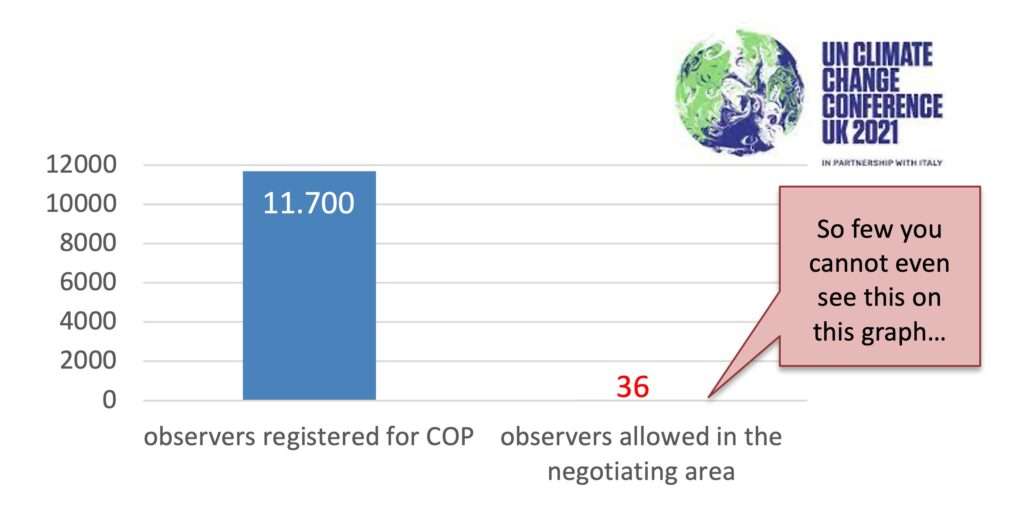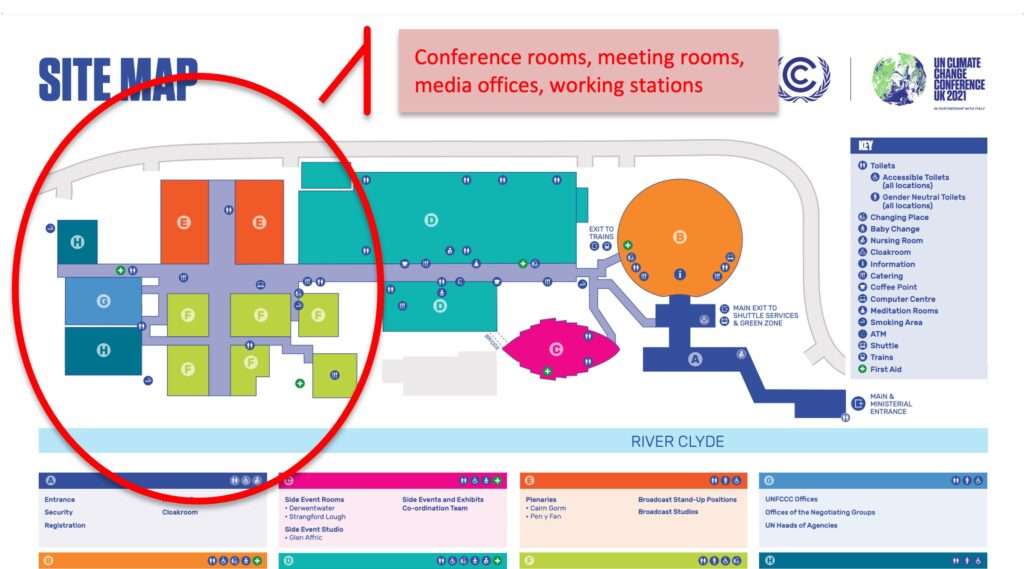Three days into COP26 and the promise of the “most inclusive COP ever” has shaped up to be nothing more than a farce with limited access and negotiations almost entirely off-limits to observers.
Alok Sharma opened the Climate Leadership Summit thanking everyone for their efforts to get to Glasgow, and it’s true: Delegates, civil society representatives, observers, and climate activists have spent months — if not years — on their plans. For weeks, there have been news stories that range from delegations trying to decipher statements about if and when they could come, to interviews with people trying securing access to the COVID vaccine and determining whether or not it was even an option in their country, and social media posts from activists crowdfunding money to pay for increased rates. And despite maneuvering between vaccine apartheid and logistical hurdles, many folks have arrived only to find that COP26 is anything but inclusive.
To get a sense of why COP26 is so different, CIEL’s Communications Manager, Cate Bonacini, talked to CIEL Senior Attorney and Campaign Manager for Human Rights and Climate Change, Sébastien Duyck, about what he’s hearing and experiencing on the ground.
How do civil society representatives typically engage during a climate COP?
During a typical COP, negotiations occur during six sessions that run parallel to one another, and the sessions themselves vary depending on the topic. It’s not uncommon to have only less than fifty attendees in one while there are hundreds in another. Each negotiating team is likely to have a delegate (although bigger delegations may send more than one person), plus UN agencies and observers that include representatives from civil society and Indigenous Peoples organizations.
Typically, states are the only ones authorized to speak during negotiations, with two exceptions. First, observers can make interventions during plenaries. While it is advantageous to be on the record, these interventions often happen at the end of a session when most of the delegates have already left the room. Second, the chair of a negotiating meeting or a presiding officer can invite civil society representatives during negotiations themselves. This is, unfortunately, very rare, but it’s where interventions often matter the most, and it’s where civil society organizations are often able to really address the actual discussions and to contribute meaningfully to the negotiations.
What is making public participation and access during COP26 so different?
The current COP26 structure is placing unprecedented restrictions on who can and cannot attend negotiations, and this is having a severe impact on civil society. For example, Climate Action Network, which represents over 1,500 civil society organizations, had two tickets allowing access to the entire negotiating areas for the first two days of the negotiations. These are the places that observers typically rely on to conduct business, hold side conversations, or meet with negotiators, have been declared entirely off-access. To be clear, we’re talking about hallways and the corners of rooms — nothing particularly fancy. Still, hallways and corners are critical places for people whose voices might not otherwise be considered to meet with negotiators. And it’s part of the reason why people are so willing to come to COP despite the financial burden and the logistical challenges.
Practically speaking, that puts a strain on the two ticket-holders because they are now are responsible for covering all six negotiations — clearly an impossible task. In addition, these restrictions made it close to impossible for civil society to set up and attend bilateral meetings, and hold necessary conversations.
During the second day, Seb took to Twitter to share two images highlighting inequities. The first shows the number of registered observers compared to those allowed into negotiations. The second provides an illustration of how observers are limited in the negotiating space.
Why is this important?
As I mentioned, civil society and observers play a critical role in monitoring negotiations and — at critical moments — lifting up concerns that might not otherwise be expressed. Two days into negotiations, we do not know what is going on inside as we should and have had limited interactions with negotiators — because even the virtual platform needs to be fixed. This really impacts our work as there have been negotiations on all key discussions happening, including on ambition, how States can deliver on finance, loss and damage, and Article 6 (for which we saw draft text on Monday night).
Ultimately, this is why there is so much anger among attendees and people who traveled to Glasgow. This is the point during negotiations when people typically have the most access to negotiators, so observers, including Indigenous Peoples, people from the Global South, and civil society play an essential role. I should also note that observers tend to be kicked out of the room when debates really heat up, which is all the more reason to ensure the window for their participation remains open as long as possible.
The COP26 Presidency and the UNFCCC Secretariat had two years to deliver on their pledge to hold the “most-inclusive COP ever,” and this is why we’re particularly alarmed — modalities have not been designed in a way that makes public participation possible. As organizers of the conference, they have a duty, under international legal obligations to ensure that the voices of those most impacted by climate change and by climate responses will be heard in the room.
What are people doing instead?
During these first two days, we have been telling our peers to stay in their hotels. Unfortunately, over the first two days, there has been limited engagement. We only had access to a couple of restaurants, the supermarket, and the Climate Fair, but not the political process itself. So this is the problem that many people, particularly those who came to Glasgow from developing countries, face.
These are delegates who traveled through difficult situations during a pandemic, people who risk bringing the virus back to their home countries, who have been through (and will go through again) periods of quarantine, all so that they can stay in their overpriced hotels and be excluded from the process. It is ridiculous.
And it’s leading to activists like Greta Thunberg declaring to a crowd assembled outside of the conference, “Change is not going to come from inside there. That is not leadership — this is leadership.”
How can the situation be remedied?
Leaders taking the stage have told multiple, harrowing stories about what is happening on the front lines of the climate emergency. But as long as they continue to exclude civil society, Indigenous Peoples, and participants from Global South, leaders are all but certain to pat themselves on the back for a job well done while continuing to deliver weak ambition and conducting business-as-usual.
As long as observers are excluded from the process, climate negotiations will run the risk of unfolding under an “out-of-sight, out-of-mind” mentality. When people with lived experiences from the frontlines of the climate emergency and the fossil fuel buildout are in the room, it becomes a lot harder to ignore what’s happening in real-time. The voices of those directly impacted by climate change and whose lived experience can actually inform the negotiation in the room. They provide valuable incentives and public scrutiny for governments to make the right decisions. These are often decisions that push negotiators beyond their comfort zone.
We also know that the voices and experiences of those representatives from civil society organizations and Indigenous Peoples’ organizations are critical when it is time to make decisions that could result in projects that might harm communities because of their focus on false solutions or carbon trading mechanisms that might not have the adequate safeguards in place.
If there is any hope of conducting negotiations that uphold human rights and advance bold ambition, we desperately need negotiating spaces to be opened and negotiators to hear their perspectives.
To accomplish this, the UNFCCC Secretariat and the UK presidency must urgently work together to ensure avenues for robust, effective participation as soon as possible. Until then, this will continue to be the COP of the moneyed, elite, Global North, and there is a real risk that decisions will come at the expense of those locked out of the room.
The cover image was provided by Kristen Poppleton, Climate Generation (climategen.org/cop26).


